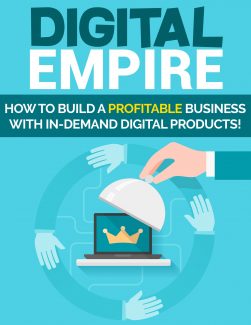 License Type: Private Label Rights
License Type: Private Label Rights  File Type: ZIP
File Type: ZIP
 SKU: 62416
SKU: 62416  Shipping: Online Download
Shipping: Online Download
Sample Content Preview
Introduction
If you’ve been looking for a fast and easy way to build a profitable online business, look no further than digital products.
When it comes to selling physical products, you’ll spend a lot of time and energy dealing with the complexities associated with shipping, fulfillment, inventory, and management.
With digital products, you’ll never have to worry about any of that!
Not to mention ever-changing industries that can shift in favor of digital virtually overnight. Just think about the rise of digital music for example, versus those who still purchase CD’s. The same for the growing number of people who pay for streaming access to movies versus those who still purchase DVD’s.
Here’s a fun fact: digital sales surpass physical sales in many other industries as well!
Digital products are not only easy to create, but they can be easily replicated and turned into multiple product lines that fuel an unlimited number of sales funnels.
They’re also consistently in demand, easy to deliver, and if you never want to write a line of content yourself, you can affordably outsource everything!
So, the question is: what kind of digital products are the most profitable?
The answer is surprisingly a rather simple one: any digital product that caters to a consistent demand within an evergreen niche market.
An evergreen market is one that consumers are interested in for years to come. They aren’t based on a fad or current trend, but rather on fulfilling an ongoing demand from a loyal audience.
These markets are filled with die-hard fans, or people who have a strong passion and interest in products and services related to the niche.
So, it makes sense that when you’re considering what digital products to create, you should focus specifically on these types of markets!
In the first chapter, we’ll dive into the different digital product formats that are not only easiest to create and sell, but that people are actively looking for (and already buying!).
I’ll then take you down the digital product rabbit hole where I’ll show you exactly how to gauge overall interest, demand and profitability of a niche before you even begin to create your products.
This one step will maximize your chances of success because you’ll base your digital products on proven winners.
Later, I’ll show you how you can easily use existing content to create outstanding digital products that will sell like wildfire.
Are you ready to enter the insanely profitable world of digital product creation so you can set yourself on the path to success?
Then let’s begin!
Uncovering Digital Goldmines
When it comes to creating profitable digital products, you’ll want to begin by analyzing what is already selling.
This sounds like common sense, right? Yet you may be surprised at how many people overlook this step and go on to create digital products in formats that no one cares about.
For example, if you were interested in creating a course that catered to new self-published authors who were looking to build their social following, you’d quickly discover that most of those entrepreneurs are interested in eBooks, courses, reports and step-by-step video instruction.
They want to read about the steps they need to take to grow their audience and connect with their readers’ base.
They want to watch how they can find relevant keywords for their books, or build an author platform using Wordpress.
Most of them won’t be interested in software, audio, music, stock photos, or most web-based applications. That’s not to say that none of those people would prefer those formats, but the majority are interested in the other types of content and training tools.
So, you need to know your audience, and the easiest way to find out what they’re most interested in is by analyzing the types of digital products they’re already buying.
You can find your audience many ways, including:
Facebook Groups
http://Facebook.com/groups
This is a fantastic way to gauge overall demand of a niche. By looking for groups that consist of active members who are avidly discussing the niche, you’ll be able to quickly find an unlimited number of hot niches and then qualify them.
Start by searching Facebook using relevant keywords under the “Find Groups” tab. If I were looking for groups pertaining to low carb recipes, I’d type in something like: “Low Carb Diet”, or “Low Carb Recipes”.
Look for groups that are active and include at least 1,000 members. While smaller, more segmented groups can also include profitable niches, when you’re just starting out it’s wise to focus on creating digital products that appeal to a wider audience.
Don’t spam the groups you join! You’re there to gauge interest and to spy on conversations to determine what people are most interested in. So, pay attention to recurring questions and threads that include common, ongoing discussion.
Facebook groups are a goldmine of helpful information that you can use to form the outline for your digital product.
http://www.Pinterest.com
Pinterest is a great resource for those who are looking for digital product ideas that sell, or trend-influenced product categories.
With this social media giant, catering to over 180 million active monthly users, you’re able to follow popular boards that are focused on niches you’re evaluating to see what people are sharing and what they are saying about it.
You can begin by browsing Pinterest’s most popular topics here: https://www.pinterest.com/categories/popular
You can also use Pinterest’s general search to discover new niches, quickly gauging popularity based on the number of followers an account has or the number of re-pins (shares) on any given board.
It’s an easy way to generate a quick snapshot of a potential niche’s overall demand.








